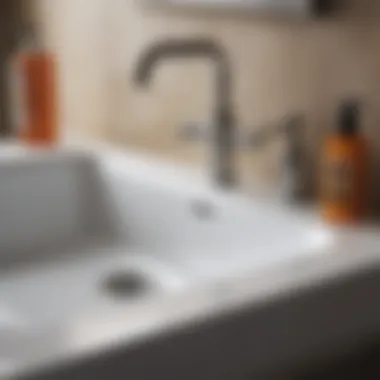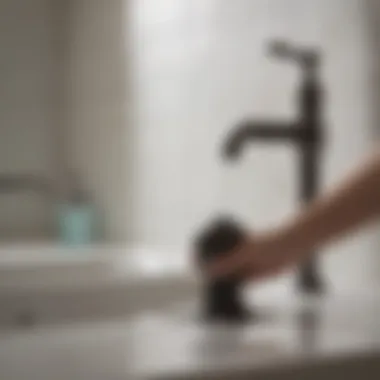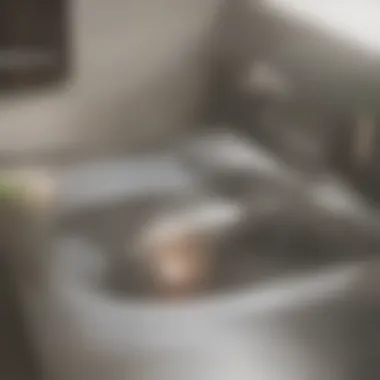Unclog Your Bathroom Sink Drain with Ease


Intro
A clogged bathroom sink drain is an all-too-common issue that can cause frustration and inconvenience. Understanding how to effectively resolve clogs is essential for homeowners. This guide not only examines the causes of clogs but also introduces the tools necessary for the task. More importantly, it provides a clear, step-by-step process to tackle this problem.
Common Causes of Bathroom Sink Clogs
Bathroom sinks often face blockages due to various reasons. Hair, soap residue, toothpaste, and other debris frequently contribute to the buildup. Over time, these materials can form significant clogs, leading to slow drainage or complete blockage. Regular maintenance can help prevent such issues, but when clogs occur, knowing how to address them effectively is crucial.
Tools You Will Need
Having the right tools on hand can make unclogging your sink a manageable task. Here are some essential tools you should consider:
- Plunger: This tool is often the first line of defense. A standard cup plunger works well for most sink issues.
- Drain Snake: A drain snake is useful for deeper clogs when plunging does not suffice. It can navigate bends and reach further into the pipe.
- Baking Soda and Vinegar: This combination can help break down minor clogs chemically and is also a good maintenance tip.
- Bucket: A bucket is important for catching water that may spill when you disassemble any sink components.
- Adjustable Wrench: Useful for loosening and tightening drain pipes if necessary.
Step-by-Step Process to Unclog Your Sink
- Remove Standing Water: Before you begin, remove any standing water. Use a bucket or a small container to catch the water from the sink.
- Use the Plunger: Place the plunger over the drain hole and ensure a tight seal. Push down firmly and pull up quickly. Repeat this several times to create pressure in the pipes.
- Check the P-Trap: If the plunger does not work, you may need to check the P-trap under the sink. Loosen the slip nuts with an adjustable wrench and remove the trap. Clean out any debris inside.
- Insert the Drain Snake: If the clog persists, carefully insert the drain snake into the pipe. Twist and push until you feel resistance. This resistance is likely the clog. Pull the snake out slowly, removing any hair or debris.
- Pour Baking Soda and Vinegar: To help clear the remaining debris, pour half a cup of baking soda and half a cup of vinegar down the drain. Allow it to bubble and sit for 30 minutes, then flush with hot water. This method can prevent future clogs.
- Reassemble and Test: Finally, reassemble any components you removed. Turn on the faucet and check if water flows smoothly. If it does, your sink should now be unclogged.
"Regular maintenance of your drains can prevent clogs and save time and effort in the long run."
Culmination
Dealing with a clogged bathroom sink drain can be straightforward when approached systematically. By understanding the causes, equipping yourself with the right tools, and following a clear process, you can maintain your sink efficiently. Regular vigilance helps to ensure that minor clogs do not escalate into significant issues, keeping your home aesthetics in top shape.
Prologue to Clogged Sink Drains
Clogged sink drains are a common issue faced by many homeowners. They can disrupt daily routines and create unpleasant environments in the bathroom. Understanding the mechanisms that lead to these clogs is essential for addressing the problem effectively. This section aims to highlight the significance of knowing how sink drains work and what to look for when clogs occur.
Understanding Sink Drain Mechanisms
To comprehend clogs, one must first understand how sink drains operate. A bathroom sink drain typically consists of a few key components: the sink basin, drain pipe, and trap. The sink basin collects water and waste, which flows down into the drain pipe. The trap, a curved section of the pipe, holds a small amount of water that forms a seal to prevent sewer gases from entering your home.
Over time, waste products such as hair, soap residue, and mineral buildup can accumulate, obstructing the flow of water. Recognizing this build-up early can save homeowners considerable time and expense in repairs. By maintaining good awareness of the sink's functionality, one can identify potential issues before they turn into serious problems.
Common Indicators of a Clogged Sink
Several signs may indicate that your bathroom sink drain is clogged. Recognizing these signs can prompt timely intervention:
- Slow Draining Water: The most noticeable sign is when water drains slowly. This is often the first indicator of a clog.
- Unpleasant Odors: A buildup in the drain can cause foul smells to emanate, signaling the need for cleaning.
- Gurgling Sounds: If you hear gurgling noises, it may suggest air trapped in the pipes due to a blockage.
- Water Backup: Water pooling in the sink basin after using the faucet can indicate an obstruction.
"Understanding early signs of a clogged drain can prevent further damage and save significant repair costs."
By being vigilant and recognizing these indicators, homeowners can take appropriate measures to unclog their drains before more extensive issues arise.
Identifying the Cause of the Clog
Understanding the cause of a clogged bathroom sink drain is essential for effective resolution. Knowing what you are dealing with can save time and resources. Each type of clog requires a different approach, so identifying the problem allows for targeted solutions, minimizing damage to your plumbing. It also helps in implementing preventative measures to avoid future clogs.
Hair Buildup
Hair is a predominant contributor to clogs in bathroom sinks. Over time, strands of hair can accumulate around the drain and pipe, forming a tangled mass. This not only obstructs water flow but can also trap soap and other debris, further exacerbating the blockage.


Maintaining regular cleaning routines can help mitigate this issue. For example, using a drain strainer is an effective first line of defense, catching hair before it reaches the pipe. If hair buildup does occur, methods such as a plumber's snake or a simple manual retrieval may be necessary to clear the blockage.
Soap Scum Accumulation
Soap, particularly bar soap, tends to create scum that sticks to inner surfaces of drains. This buildup happens gradually and may not be noticeable at first. However, as the scum collects, it reduces the effective diameter of the pipes, leading to slow drainage and eventual clogs.
To combat soap scum accumulation, regular cleaning is advisable. I suggest using a mixture of baking soda and vinegar, which can help dissolve the soap residue. Additionally, steaming the pipes with hot water can help soften and eliminate build-up.
Foreign Objects in the Drain
It is common for small foreign objects like jewelry, toothpaste caps, and small toys to accidentally fall into bathroom sink drains. These objects can quickly become lodged in the plumbing system, causing significant clogs.
In such cases, it is crucial to act swiftly to retrieve the object before it causes further problems. A wet/dry vacuum can effectively suck out small items, while a good inspection might be able to identify more precarious blockages requiring the use of a plumber's snake.
Deteriorating Pipes
Sometimes, the issue isn't with the immediate contents of the drain but rather the pipes themselves. Older pipes, particularly those made from materials like galvanized steel or cast iron, can corrode and deteriorate over time. This decay can lead to rough surfaces that trap debris or even create obstructions.
If you suspect your pipes might be deteriorating, it's best to consult a plumbing expert. A thorough inspection can reveal the true state of your plumbing, allowing for necessary repairs or replacements. Acting before a complete failure can help avoid larger issues down the line.
Essential Tools and Materials
Unclogging a bathroom sink drain requires specific tools and materials to facilitate the process. Using the right equipment not only ensures efficiency but also minimizes damage to the plumbing system. In this section, we will explore the essential tools and materials necessary for addressing clogs effectively.
Plumber's Snake
A plumber's snake, also known as a drain auger, is a fundamental tool for addressing serious clogs that conventional methods cannot resolve. This device consists of a long, flexible metal cable with a coiled end designed to break up and remove obstructions in the drain. When using a plumber's snake, it is essential to feed it gently into the drain and slowly turn the handle to advance the auger further into the pipe. The flexibility allows it to navigate bends in the plumbing.
Benefits of using a plumber's snake include:
- Effective removal of stubborn clogs, particularly those caused by hair or foreign objects.
- Reduces the need for harsh chemical drain cleaners, which can damage pipes over time.
- Offers a practical solution for deeper clogs that resist other methods.
Wet/Dry Vacuum
A wet/dry vacuum is a versatile tool that can handle both liquid and solid waste. Using a vacuum to unclog a sink can be very effective, especially when the clog is near the surface. This method creates suction that can lift out build-up or foreign objects without causing damage to the pipe.
Considerations when using a wet/dry vacuum:
- Make sure to set the vacuum to liquid mode to effectively draw out the clog material.
- Always wear gloves to protect your hands from messes.
- Ensure that the vacuum is properly sealed to maximize suction.
Baking Soda and Vinegar
Baking soda and vinegar are commonly recommended household items that serve as a natural alternative to chemical cleaners. This combination can assist in breaking down build-ups within the pipes. When mixed, baking soda, a base, reacts with vinegar, an acid, creating a fizzing effect that can help dissolve minor clogs and deodorize the drains.
How to use this combination:
- Pour about half a cup of baking soda down the drain.
- Follow it with a cup of vinegar and quickly cover the drain.
- Wait for about 30 minutes, then flush with hot water.
Dish Soap and Hot Water
Dish soap is another simple yet powerful material to unclog bathroom sinks. Its grease-cutting properties help to loosen buildup and provide lubrication within the pipes. When combined with hot water, it can effectively clear minor clogs without involving harsh chemicals.
Application method:


- Squeeze a generous amount of dish soap into the drain.
- Follow with a kettle of boiling water.
- Let the mixture sit for a few minutes before running hot water to flush the drain.
Taking the right approach with the proper tools maximizes the effectiveness of your unclogging efforts, ultimately leading to a more functional and clean bathroom sink.
Step-by-Step Unclogging Process
In addressing a clogged bathroom sink drain, the Step-by-Step Unclogging Process is essential. This methodical approach enables one to diagnose the problem accurately, apply the correct solutions, and, importantly, prevent future occurrences. Each step not only provides clarity but also reduces frustration often associated with recurring drain issues. The process facilitates a sense of control, empowering you to tackle problems proactively rather than reactively.
Initial Assessment
Before diving into physical solutions, conducting an Initial Assessment is crucial. Understanding the severity of the clog and observing the symptoms can direct your approach.
- Observe water behavior: Does the water drain slowly, or is it completely stagnant?
- Check for gurgling noises: Such sounds may indicate trapped air, suggesting a blockage.
- Consider past usage: Have you recently used products that might contribute to a clog?
This assessment helps in determining whether a simple remedy, such as hot water, could resolve the issue, or if more advanced tools, like a plumber's snake, should be employed.
Using a Plumber's Snake
The Plumber's Snake is a crucial tool for clearing stubborn clogs. It’s often more effective than chemical solutions and is less likely to damage pipes. Here’s how to use it:
- Insert the snake into the drain opening carefully.
- Turn the handle in a clockwise direction while pushing it deeper into the pipe. This motion helps to grab onto the clog.
- When you feel resistance, continue to twist and push until you have broken up the blockage.
- Withdraw the snake carefully, as this may bring the clog back up with it.
- Finally, run hot water down the drain to wash away any remaining debris.
Steam Cleaning with Hot Water
Another effective method is Steam Cleaning with Hot Water. Hot water can dissolve many types of blockages. Here’s a straightforward procedure:
- Boil a kettle or use a pot of water on the stove.
- Carefully pour the hot water down the drain in stages. Allow it to sit for a few moments between pours.
- This can often help in dislodging soap scum or organic material caught within the pipe.
Bear in mind to never pour boiling water if your pipes are PVC, as this can cause damage.
Chemical Solutions: Pros and Cons
While Chemical Solutions can be effective, they come with both advantages and disadvantages:
Pros:
- Simple to use, often requiring just one step.
- Offers quick results in dissolving certain types of clogs.
Cons:
- Chemicals can be harmful to both human health and the environment.
- Over time, harsh substances can corrode pipes, leading to more significant issues.
In summary, using chemicals requires careful consideration. It’s best reserved for extreme situations where other methods have failed.
"Using a multi-faceted approach will yield the best results in unclogging bathroom sink drains effectively. It combines hands-on techniques with thoughtful assessments."
By following these steps and understanding the nuances of each method, addressing a clogged sink drain becomes more manageable, contributing to the overall maintenance of your bathroom.
Preventative Measures to Avoid Future Clogs
Preventing clogs in your bathroom sink can save you time and money. Regular upkeep makes a significant difference in minimizing the risk of blockages. Understanding the actions to take will help maintain the functionality of your plumbing. This section will explore specific practices that can reduce the potential for future obstructions in your sink.
Regular Maintenance Practices


Performing consistent maintenance is essential. It keeps drains clear and helps you catch minor issues before they escalate. A few effective practices include:
- Cleaning drains periodically: Try to clean your sink drain every month using baking soda and vinegar. This combination helps dissolve any organic buildup.
- Flushing with hot water: Pouring hot water down the drain can help remove sludge and soap scum, keeping the pipes clean.
- Routine inspection: Check for slow-draining water. If noticed, it could indicate a developing clog.
These small steps can effectively reduce the chances of more severe clogs in the future. Regular maintenance adds to the long-term health of your plumbing system.
Utilizing Drain Strainers
Drain strainers serve as a crucial defense against clogs. They trap hair, soap particles, and larger debris that can cause blockages. Installing a simple mesh strainer over the drain should be your first line of defense. Here are some practical tips:
- Choose the right size for your sink. Strainers must fit well to effectively collect debris without allowing it to pass through.
- Clean the strainer frequently. This ensures it functions optimally, preventing the accumulation of materials that may otherwise clog the drain.
- Consider using a strainer with a dual function, such as one that also acts as a stopper for the sink. This versatility can increase its utility in your bathroom.
In summary, using drain strainers is an inexpensive and efficient method to keep your sink free from clogs.
Educating Family Members
Education is critical in maintaining a clog-free bathroom sink. It involves informing all household members about proper sink usage and care. Here’s what to consider:
- Discuss what can and cannot go down the drain. For example, avoid letting hair, food particles, and greasy substances enter the sink.
- Encourage proper cleaning habits. Remind family members to clean their hair out of the strainer after use.
- Create a household routine for checking drains. Regular checks can help everyone be aware of any signs of potential problems.
By instilling good habits among family members, you foster a shared responsibility for maintaining clear drains. This approach can yield substantial benefits in preventing future plumbing issues.
When to Call a Professional
Knowing when to seek help from a plumbing expert can save you time, money, and frustration. While many clogs can be resolved with DIY methods, some situations require professional intervention. Understanding specific indicators can guide homeowners in making informed decisions.
Signs Indicating a Serious Problem
Some signs can point to a more severe plumbing issue. If you notice any of the following, it is prudent to call a professional:
- Persistent Clogs: If multiple attempts to unclog the sink fail, the issue may relate to a more significant obstruction deeper in your plumbing system.
- Backflow of Water: Seeing water come up in other sinks or fixtures can indicate a significant blockage in the main drain line.
- Foul Odors: A strong smell often suggests buildup or decay in the pipes. This could result from waste or stagnant water.
- Gurgling Sounds: Unusual noises during drainage indicate air trapped in your plumbing, which often stems from a blockage.
- Leaking Pipes: Visible leaks or corrosion might signal deterioration that can lead to more significant issues. You should address these immediately.
"Ignoring these signs can exacerbate plumbing issues, leading to costly repairs."
These symptoms should not be overlooked. They signify that the problem might be beyond typical buildup and requires more specialized equipment and knowledge to rectify.
Choosing the Right Plumbing Service
Selecting a qualified plumber requires careful consideration. Factors to assess include:
- Experience: Look for a plumber with years in the field who is accustomed to dealing with various plumbing scenarios.
- Reviews and Recommendations: Investigate customer feedback on platforms like Reddit or local business directories. Positive reviews can indicate reliability and skill.
- Licensing and Insurance: Confirm that the plumber holds necessary licenses and carries liability insurance. This protects you from any mishaps during the job.
- Cost Transparency: A reputable plumber should provide estimates upfront. Be cautious of hidden fees or vague pricing methods.
- Availability: Emergencies can happen anytime. Choose a service that can respond quickly to urgent issues.
In sum, while patience and DIY efforts can manage many minor drain issues, understanding when it’s time to consult a professional is essential. This not only ensures effective solutions but also maintains the integrity of your home's plumbing system.
Finale
The conclusion of this article is vital as it encapsulates the key takeaways regarding unclogging bathroom sink drains. A clear understanding of the information presented can empower homeowners and design enthusiasts to manage their plumbing issues more effectively. Clogs may seem like a minor inconvenience, yet they can escalate into significant problems if neglected. Addressing them promptly not only preserves the functionality of the home but also contributes to its overall appeal and performance.
Summary of Techniques
To summarize, several techniques can be systematically employed to tackle a clogged sink. Here is a straightforward recap:
- Initial Assessment: Identifying the nature of the clog often directs the right method for resolution.
- Plumber's Snake Use: A practical tool to break through bacterial buildup or foreign objects.
- Steam Cleaning with Hot Water: This method can dissolve soap scum or organic material effectively.
- Chemical Solutions: These should be handled with care, considering both their efficacy and environmental implications.
- Regular Maintenance: Adopting preventive measures can save time and hassle in the long run.
"Regular checks and maintenance are not just chores; they are investments in the long-term functionality of your home."
Encouragement of Regular Checks
Engaging in regular checks of your sink's drainage system is not simply a good practice; it is essential for maintaining a functional and aesthetically pleasing home. Setting a routine for inspections can identify early signs of trouble before they evolve into complicated and costly issues. Encourage family members to be part of these checks, fostering a habit of awareness and care regarding home maintenance. By doing so, it helps cultivate an environment where proper usage and care are paramount. Implementing this habit pays dividends not only in the form of peace of mind but also in sustaining the value of the property.







